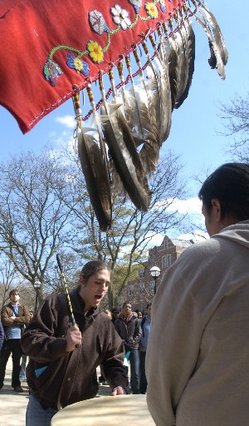University of Michigan hires staff to assist in returning Native American remains
The University of Michigan is hiring two new staff members to help return Native American remains and objects from its museum collection to tribes that can show a geographical link to them under a federal law that took effect earlier this month.
Stephen Forrest, U-M’s vice president for research, said he anticipates Native American tribes will file claims for the return of the bones of virtually all of the 1,600 individuals in the collection of the U-M Museum of Anthropology. That collection is not open to the public.
“The university right now is doing everything right,” said Veronica Pasfield, a U-M graduate student who is the external co-chair of the Native Caucus, a group of indigenous graduate students, and the repatriation officer of the Bay Mills Indian Community. "I think that they are working with transparency, they're working very hard to attain full disclosure, and I believe they are sincerely focused on creating empowered tribal collaboration."
U-M and some Native American tribes have been at odds for years over some of the remains.
The 1990 Native American Graves Protection and Repatriation Act, known as NAGPRA, established the right of Native Americans to claim the return of items in the collections of institutions that receive federal funding. Items could be returned to lineal descendents or current Native American tribes that show a cultural affiliation to them - essentially a shared group identity demonstrated through historical evidence and other factors.
Museums had to inventory their holdings, make the information available, and notify tribes that might have a claim.

University of Michigan junior Frank Bartley III, an Odawa Indian, beats a drum and sings with other Native Americans at a rally in front of the Fleming Building in 2008.
File photo
Native groups faulted U-M, saying it did not properly share information or consult them. In 2008, members of the Saginaw Chippewa Indian Tribe of Michigan rallied outside the Fleming Building before a meeting of the U-M Board of Regents, seeking the return of the remains of 405 people. Those remains had been excavated in the 1930s and 1960s from three sites in Michigan.
Although U-M returned some items, it deemed the items sought by the Saginaw Chippewas - along with the majority of its collection - as being without cultural affiliation. U-M maintained the federal law required it to hold onto the items until the government issued additional rules.
That happened several months ago, and on May 14, the new federal rule took effect. It created a process for returning those items under less stringent criteria.
Current-day tribes can claim bones and objects based on a geographical link to the sites from which the items were originally taken.
When a tribe makes a claim, U-M will identify all of the remains taken from that tribe’s county, then notify other tribes that may also share a geographical connection.
If multiple tribes make claims to the same items, U-M can host a meeting for the tribes to discuss their claims and provide more information, but the university has to let the tribes resolve the dispute, said Forrest.
He said the two new staff members - one in his office and one in the anthropology museum - are needed to help the university respond quickly to any claims and update its catalogue and website. Information on the remains is published on a U-M website.
Last fall, Forrest named a 12-member advisory council to give advice and guidance on the procedures used to notify and consult with tribal groups.
U-M also named Carla Sinopoli as its new NAGPRA coordinator. Sinopoli is the director of the anthropology museum and curator of its Asian archeology collection.
She replaced John O’Shea, the curator of Great Lakes archeology, who had been at odds with some native groups on campus and has said there are valid reasons for holding onto some of the remains.
“John helped both the university and the tribes over the years identifying many remains but we’re doing it differently now,” Forrest said.
Dave Gershman is a freelance writer for AnnArbor.com. Reach the news desk at news@annarbor.com or 734-623-2530.


Comments
Eric
Mon, May 24, 2010 : 1:56 p.m.
The national NAGPRA program manager Sherry Hutt is not using the clearly articulated definition of indian Tribe contained in the NAGPRA regulation's preamble. Nor is she using the list of indian tribes created pursuant to the Act. Instead they are using the already discarded narrower BIA list. If anyone gives away our Non-BIA acknowledged tribe's remains without first honoring the NAGPRA preamble's clearly articulated definition of "Indian Tribe" and the list of Indian Tribes created specifically for the Act, our attorney's will file a claim against you for "Taking" Please stop this madness and honor the Act. eric@maidu.com
Tim
Mon, May 24, 2010 : 12:27 p.m.
Remember why they closed the exhibit? Because it was too close to the dinosaur exhibit.... I haven't gone there since.